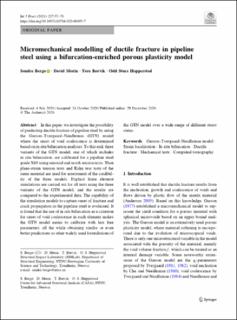| dc.contributor.author | Bergo, Sondre | |
| dc.contributor.author | Morin, David | |
| dc.contributor.author | Børvik, Tore | |
| dc.contributor.author | Hopperstad, Odd Sture | |
| dc.date.accessioned | 2021-11-03T07:07:01Z | |
| dc.date.available | 2021-11-03T07:07:01Z | |
| dc.date.created | 2021-05-10T14:24:36Z | |
| dc.date.issued | 2021 | |
| dc.identifier.citation | International Journal of Fracture. 2021, 227 (1), 57-78. | en_US |
| dc.identifier.issn | 0376-9429 | |
| dc.identifier.uri | https://hdl.handle.net/11250/2827384 | |
| dc.description.abstract | In this paper, we investigate the possibility of predicting ductile fracture of pipeline steel by using the Gurson–Tvergaard–Needleman (GTN) model where the onset of void coalescence is determined based on in situ bifurcation analyses. To this end, three variants of the GTN model, one of which includes in situ bifurcation, are calibrated for a pipeline steel grade X65 using uniaxial and notch tension tests. Then plane-strain tension tests and Kahn tear tests of the same material are used for assessment of the credibility of the three models. Explicit finite element simulations are carried out for all tests using the three variants of the GTN model, and the results are compared to the experimental data. The capability of the simulation models to capture onset of fracture and crack propagation in the pipeline steel is evaluated. It is found that the use of in situ bifurcation as a criterion for onset of void coalescence in each element makes the GTN model easier to calibrate with less free parameters, all the while obtaining similar or even better predictions as other widely used formulations of the GTN model over a wide range of different stress states. | en_US |
| dc.language.iso | eng | en_US |
| dc.publisher | Springer | en_US |
| dc.rights | Navngivelse 4.0 Internasjonal | * |
| dc.rights.uri | http://creativecommons.org/licenses/by/4.0/deed.no | * |
| dc.title | Micromechanical modelling of ductile fracture in pipeline steel using a bifurcation-enriched porous plasticity model | en_US |
| dc.type | Peer reviewed | en_US |
| dc.type | Journal article | en_US |
| dc.description.version | publishedVersion | en_US |
| dc.source.pagenumber | 57-78 | en_US |
| dc.source.volume | 227 | en_US |
| dc.source.journal | International Journal of Fracture | en_US |
| dc.source.issue | 1 | en_US |
| dc.identifier.doi | 10.1007/s10704-020-00495-7 | |
| dc.identifier.cristin | 1909215 | |
| cristin.ispublished | true | |
| cristin.fulltext | postprint | |
| cristin.qualitycode | 1 | |

